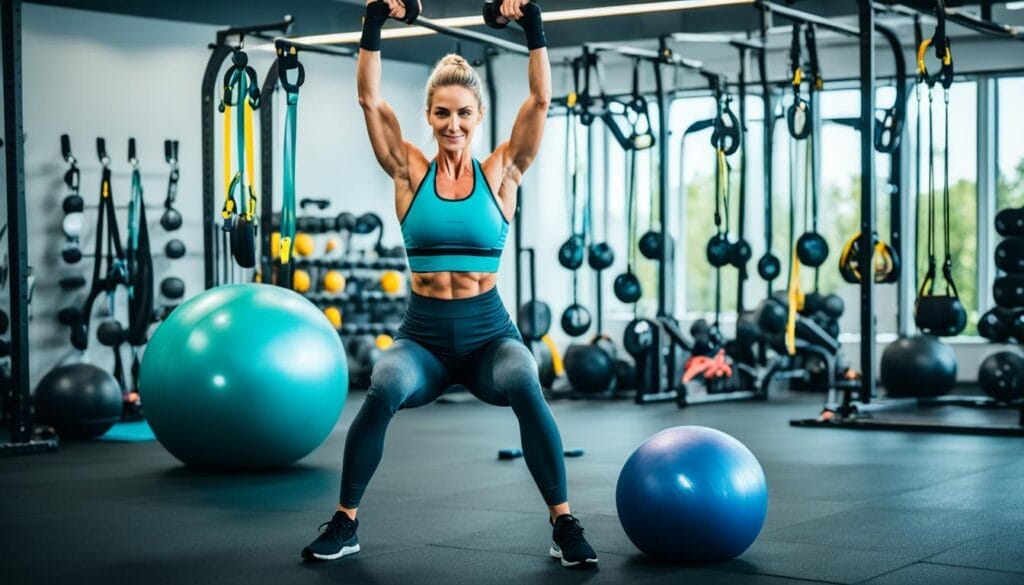As I reflect on my fitness journey, I can’t help but marvel at the incredible transformation I’ve experienced since incorporating functional strength training into my routine. It all started with a desire to improve my overall fitness and enhance my everyday movements. Little did I know that this decision would not only reshape my physique but also nurture a deep sense of confidence and empowerment within me.
I’ve always been passionate about staying fit and leading a healthy lifestyle. However, standard gym exercises alone never quite satisfied my craving for a more dynamic and purposeful approach to fitness. It wasn’t until I discovered functional training that everything fell into place.
Functional strength training is not just about building muscles and attaining a toned physique. It’s about honing the body’s ability to perform real-life activities with ease and efficiency. From lifting heavy grocery bags to bending down to tie my shoelaces, functional training has equipped me with the strength, stability, and coordination to conquer any physical challenge that comes my way.
But it’s not just the physical benefits that make functional training so meaningful to me. It’s the profound impact it has had on my overall well-being. The sense of accomplishment I feel after completing a challenging functional workout is unparalleled. Knowing that I am constantly pushing my limits and becoming stronger, both mentally and physically, fills me with an indescribable sense of satisfaction.
Functional strength training has truly become an integral part of my life. It has not only improved my performance in other sports and activities but has also enhanced my overall quality of life. The everyday movements that used to feel arduous and tiring have become effortless and enjoyable.
Join me on this journey as I delve deeper into the world of functional strength training. Together, we will explore the benefits, understand the training principles, and discover effective routines that will elevate our fitness and unleash our full potential.
Key Takeaways
- Functional strength training enhances everyday movements, making tasks easier and more efficient.
- It goes beyond building muscles, focusing on core strength, stability, and coordination.
- Functional training brings a sense of accomplishment and fulfillment.
- It improves overall quality of life by making everyday activities effortless.
- Join me on this journey to unlock the power of functional strength training.
Understanding Functional Training
Functional training is a holistic approach to fitness that focuses on exercises which mimic everyday movements. Unlike traditional strength training that isolates specific muscle groups, functional training engages multiple muscles and joints simultaneously, leading to enhanced overall functional fitness.
By incorporating exercises that mirror real-life activities such as squatting, reaching, and carrying heavy objects, functional training improves core strength, stability, and flexibility. This not only helps you perform daily tasks with ease but also aids in injury prevention by strengthening muscles and joints.
Functional training is all about making your workouts more practical and applicable to your daily life. By simulating everyday movements, you can better prepare your body for the physical demands you face on a regular basis. Whether it’s lifting groceries, picking up your child, or even playing a sport, functional training helps you perform these activities more efficiently and with reduced risk of injury.
One of the key benefits of functional training is its focus on core strength. The core muscles, including the abdominals, back, and hip muscles, are essential for providing stability and balance during movement. By targeting these muscles in a functional training routine, you can develop a strong and stable core, enhancing your ability to perform various physical tasks with greater ease and efficiency.
Multi-muscle exercises are the cornerstone of functional training. These exercises involve multiple muscle groups and joints working together, mimicking the coordination required for real-life movements. By engaging the body as a whole, rather than isolating specific muscles, multi-muscle exercises help improve overall strength, endurance, and coordination, leading to improved functional fitness.
Injury prevention is another crucial aspect of functional training. By strengthening the muscles and joints that are involved in everyday movements, functional training helps reduce the risk of injuries during activities such as lifting, bending, and twisting. This is particularly important as we age, as maintaining functional fitness becomes essential for maintaining independence and quality of life.
| Benefits of Functional Training |
|---|
| Enhanced performance in everyday activities |
| Improved core strength, stability, and flexibility |
| Reduced risk of injuries |
| Increased functional fitness |
Functional training is a dynamic and effective way to improve your fitness and overall well-being. By incorporating functional exercises into your workout routine, you can enhance your everyday movements, develop core strength, engage multiple muscle groups, and prevent injuries. Whether you’re a fitness enthusiast or just looking to improve your functional fitness, functional training offers a practical and sustainable approach to achieving your goals.
Maximising Your Functional Training
To maximise your functional strength training, I have found that staying consistent with my workouts is key. Even if I am unable to access a gym or traditional exercise equipment, I have discovered that using household objects can be a great alternative. For example, I fill water jugs and use them as weights to add resistance to my exercises.
Keeping my workouts simple has also been effective in maximising my functional training. I focus on multi-muscle, multi-joint exercises that engage multiple muscle groups at once. This not only saves time but also provides significant benefits for my overall strength and stability.
To ensure I stay on track and make progress, I follow foolproof routines. Incorporating exercises like glute bridges, squats, push-ups, lateral lunges, and planks into my workouts has been a game-changer for my functional strength. These exercises target multiple muscle groups and improve core strength and stability, which are crucial for everyday movements.
The key to maximising your functional training is to stay consistent, even if you don’t have access to a gym. By using household objects as weights and focusing on simple routines that target multiple muscle groups, you can maintain and improve your functional strength.
Beginner Routine for Functional Strength
If you are new to strength training or have taken some time off, starting with a bodyweight routine can be highly beneficial. By using your own bodyweight, you can effectively target multiple muscle groups and improve your overall functional fitness.
I recommend incorporating exercises like the glute bridge, squat, push-up, lateral lunge, and plank into your beginner routine. These exercises are simple yet effective in building core strength, stability, and functional strength. Here’s how you can structure your workout:
- Exercise 1: Glute Bridge
- Reps: 12
- Sets: 3
- Rest: 30 seconds between sets
- Reps: 12
- Sets: 3
- Rest: 30 seconds between sets
- Reps: 12
- Sets: 3
- Rest: 30 seconds between sets
- Reps: 12 (6 reps per side)
- Sets: 3
- Rest: 30 seconds between sets
- Hold: 30 seconds
- Sets: 3
- Rest: 30 seconds between sets
Perform each exercise with proper form and technique. Take a 30-second rest between sets and exercises to allow your muscles to recover. As a beginner, focus on mastering the correct form before progressing to heavier weights or more advanced variations of the exercises.
Remember, consistency is key when starting a new fitness routine. Make time for your workouts and gradually increase the intensity as you build strength and confidence.

Adding a bodyweight routine to your fitness journey is a great way to improve your functional strength without the need for expensive equipment. Start with these exercises, gradually increase the intensity, and watch as your strength and stability improve over time.
Intermediate Routine for Functional Strength
Once I feel confident with the beginner routine and can easily complete the desired reps, I can progress to an intermediate routine. This routine includes a variety of exercises that target multiple muscle groups and further enhance my functional strength and power.
Here are some exercises that I incorporate into my intermediate routine:
- Step-up to Shoulder Press: This exercise not only works my lower body but also engages my shoulders and arms. By combining a step-up with a shoulder press, I am able to challenge my balance and coordination while building strength in multiple muscle groups.
- Deadlifts: Deadlifts are a compound exercise that primarily targets my glutes, hamstrings, and lower back. By performing deadlifts with proper form and technique, I can develop my posterior chain strength and enhance my overall functional fitness.
- Goblet Squats: Goblet squats are a great exercise for targeting my lower body, specifically my quadriceps, hamstrings, and glutes. By holding a dumbbell or kettlebell close to my chest, I can maintain proper form and increase the intensity of the squat.
- Single-leg Dumbbell Rows: This exercise helps improve my upper body strength and stability. By performing rows in a single-leg stance, I engage my core and challenge my balance while targeting my back muscles.
- Woodchops: Woodchops are a functional exercise that mimics the movement of chopping wood. This exercise engages my core, shoulders, and oblique muscles. By using a resistance band, cable machine, or dumbbell, I can add resistance and increase the challenge.
During my intermediate routine, I aim for 3 sets of 10 to 12 reps for each exercise. It is important to ensure that the last few reps of each set challenge me while maintaining proper form. By using light to moderate-weight dumbbells and focusing on compound movements, I continue to progress in my functional strength training journey.

By incorporating these exercises into my intermediate routine, I continue to improve my overall functional strength, stability, and power. The combination of compound movements and targeted muscle engagement helps me excel in everyday activities and prevent injuries.
Advanced Routine for Functional Strength
Once you have mastered the intermediate routine and feel strong, you can progress to an advanced routine. This routine will take your functional strength training to the next level, targeting key muscle groups and challenging your balance, stability, coordination, and power.
Exercises to Include:
- Single-leg Romanian Deadlift: This exercise focuses on your hamstrings, glutes, and lower back. Stand on one leg, hinge at the hip, and lower the weights while keeping your back straight. Repeat on the other leg.
- Front Squat: Target your quads, glutes, and core with this variation of the squat. Hold the weights in front of your shoulders, elbows up, and squat down, keeping your chest lifted.
- Offset Loaded Carry: Enhance your grip strength and core stability by carrying weights in one hand while walking. Keep your shoulders level and core engaged.
- Rotational Chop: Engage your obliques and rotational power with this exercise. Hold a weight with both hands, rotate your torso, and “chop” the weight across your body.
- Kettlebell Swing: Develop explosive power and strengthen your entire posterior chain with kettlebell swings. Hinge at the hips, swing the kettlebell between your legs, and explosively drive your hips forward to swing it to shoulder height.
Aim for 3 sets of 10 to 12 repetitions for each exercise, focusing on maintaining proper form and gradually increasing the weight or intensity as you progress. Incorporating these advanced exercises into your routine will challenge your limits and help you achieve peak functional strength.
The Benefits of Functional Training
Incorporating functional training into my fitness routine offers numerous benefits. By improving my functional fitness, I enhance my ability to perform everyday activities more efficiently. This leads to an improved quality of life, increased independence, and reduced risk of injuries.
Functional training is versatile and can be adapted to various levels of fitness and age groups. It allows me to engage in a wide range of movements that have practical applications in daily life, making it a sustainable long-term fitness solution. Whether I need to lift heavy objects, climb stairs, or participate in recreational activities, functional training enhances my performance and ensures that I can enjoy life to the fullest.
Functional training doesn’t just focus on isolated muscles; it trains multiple muscles and joints simultaneously, mimicking the movements I perform every day. This approach makes my body more proficient at performing these movements, so I can excel in my work, hobbies, and everyday tasks.
- Enhanced everyday activities: Functional training improves my strength, stability, balance, and flexibility, enabling me to tackle tasks with ease. Whether it’s carrying groceries, playing with my children, or doing household chores, I feel more capable and confident in my abilities.
- Improved quality of life: Through functional training, I can enhance my overall fitness and well-being. Being physically active and having the ability to move without limitations positively impacts various aspects of my life, from my mental health to my social interactions.
- Versatility: Functional training can be adapted to suit my specific needs and goals. Whether I prefer bodyweight exercises, free weights, resistance bands, or functional fitness equipment, there are countless options to keep my workouts engaging and effective.
- Injury prevention: By training movements that mimic everyday activities, functional training helps strengthen the muscles and joints required for these movements. This reduces the likelihood of injuries and enhances my body’s ability to recover and adapt to physical stress.
- Sustainable long-term fitness: Functional training offers a holistic approach to fitness that promotes lifelong health and wellness. Unlike fad workouts or quick-fix programs, functional training focuses on building a strong foundation of functional strength and movement patterns that can be maintained for years to come.
Functional training truly revolutionises my fitness journey by providing tangible benefits that enhance my everyday life and overall well-being. Whether I’m a seasoned athlete or just starting out on my fitness path, incorporating functional training into my routine is a step towards a healthier, stronger, and more capable me.
Let's Sum Up
Functional fitness is a game-changer when it comes to exercise. It goes beyond traditional strength training and cardiovascular workouts, focusing on functional movements that replicate everyday activities. By incorporating functional training into your routine, you can enhance your overall functional strength, stability, and flexibility.
This approach to fitness offers a multitude of benefits. Not only does it improve your quality of life by making everyday activities easier and more efficient, but it also reduces the risk of injuries. Functional training promotes optimal health and well-being, allowing you to unlock your full potential.
Whether you’re a fitness enthusiast or just starting your wellness journey, don’t underestimate the power of functional training. It can transform your fitness experience by providing a practical and sustainable approach to exercise. Embrace functional fitness today and take your fitness to new heights!
FAQ
What is functional training?
Functional training refers to exercises that help you perform everyday activities more easily by using the whole body and focusing on core strength and stability.
How does functional training differ from traditional strength training?
While traditional strength training targets specific muscle groups, functional training engages multiple muscles and joints simultaneously, improving overall functional fitness and preventing injuries.
How can I maximize my functional training without access to a gym or traditional equipment?
You can use household objects like water jugs as weights and focus on multi-muscle, multi-joint exercises to still achieve significant benefits.
What exercises are suitable for beginners in functional training?
A beginner routine can include glute bridges, squats, push-ups, lateral lunges, and planks, targeting multiple muscle groups and building core strength.
What exercises can I progress to after mastering the beginner routine?
An intermediate routine can include stepup to shoulder press, deadlifts, goblet squats, single-leg dumbbell rows, and woodchops, further enhancing functional strength and power.
What exercises can I do once I feel strong enough for an advanced routine?
An advanced routine can include single-leg Romanian deadlifts, front squats, offset loaded carries, rotational chops, and kettlebell swings, challenging balance, stability, and coordination while building strength and power.
What are the benefits of incorporating functional training into my fitness routine?
By improving your functional fitness, you enhance your ability to perform everyday activities more efficiently, leading to an improved quality of life, increased independence, and reduced risk of injuries.
How does functional training promote long-term fitness?
Functional training focuses on movements with practical applications in daily life, making it versatile and adaptable to various fitness levels and age groups, promoting sustainable long-term fitness.
Share Me:
READY TO UNLEASH
YOUR BEST SELF?
Click “Sign Me Up!” And Start Your Fitness Transformation!





